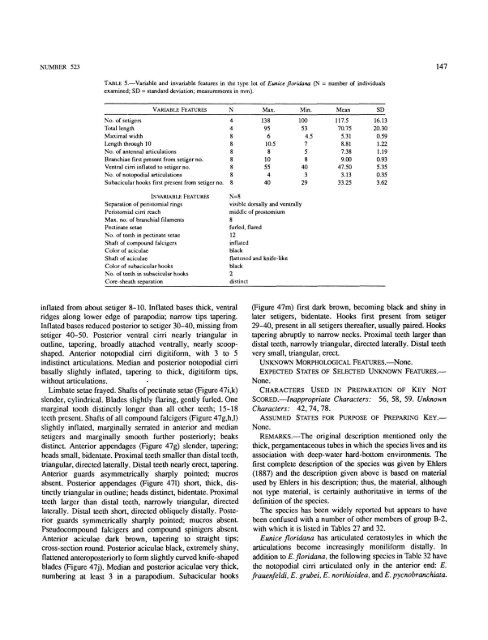A Review of the Genus Eunice - Smithsonian Institution Libraries
A Review of the Genus Eunice - Smithsonian Institution Libraries
A Review of the Genus Eunice - Smithsonian Institution Libraries
You also want an ePaper? Increase the reach of your titles
YUMPU automatically turns print PDFs into web optimized ePapers that Google loves.
NUMBER 523 147<br />
TABLE 5.—Variable and invariable features in <strong>the</strong> type lot <strong>of</strong> <strong>Eunice</strong> floridana (N = number <strong>of</strong> individuals<br />
examined; SD = standard deviation; measurements in mm).<br />
VARIABLE FEATURES<br />
No. <strong>of</strong> seligers<br />
Total length<br />
Maximal width<br />
Length through 10<br />
No. <strong>of</strong> antcnnal articulations<br />
Branchiae first present from setiger no.<br />
Ventral cirri inflated to setiger no.<br />
No. <strong>of</strong> notopodial articulations<br />
Subacicular hooks first present from setiger no.<br />
N<br />
4<br />
4<br />
8<br />
8<br />
8<br />
8<br />
8<br />
8<br />
8<br />
Max.<br />
138<br />
95<br />
6<br />
10.5<br />
8<br />
10<br />
55<br />
4<br />
40<br />
Min.<br />
100<br />
53<br />
4.5<br />
7<br />
5<br />
8<br />
40<br />
3<br />
29<br />
Mean<br />
117.5<br />
70.75<br />
5.31<br />
8.81<br />
7.38<br />
9.00<br />
47.50<br />
3.13<br />
33.25<br />
SD<br />
16.13<br />
20.30<br />
0.59<br />
1.22<br />
1.19<br />
0.93<br />
5.35<br />
0.35<br />
3.62<br />
INVARIABLE FEATURES<br />
Separation <strong>of</strong> pcristomial rings<br />
Pcristomial cirri reach<br />
Max. no. <strong>of</strong> branchial filaments<br />
Pectinate setae<br />
No. <strong>of</strong> teeth in pectinate setae<br />
Shaft <strong>of</strong> compound falcigcrs<br />
Color <strong>of</strong> aciculac<br />
Shaft <strong>of</strong> aciculae<br />
Color <strong>of</strong> subacicular hooks<br />
No. <strong>of</strong> teeth in subacicular hooks<br />
Core-sheath separation<br />
N=8<br />
visible dorsally and ventrally<br />
middle <strong>of</strong> prostomium<br />
8<br />
furled, flared<br />
12<br />
inflated<br />
black<br />
flattened and knife-like<br />
black<br />
2<br />
distinct<br />
inflated from about setiger 8-10. Inflated bases thick, ventral<br />
ridges along lower edge <strong>of</strong> parapodia; narrow tips tapering.<br />
Inflated bases reduced posterior to setiger 30-40, missing from<br />
setiger 40-50. Posterior ventral cirri nearly triangular in<br />
outline, tapering, broadly attached ventrally, nearly scoopshaped.<br />
Anterior notopodial cirri digitiform, with 3 to 5<br />
indistinct articulations. Median and posterior notopodial cirri<br />
basally slightly inflated, tapering to thick, digitiform tips,<br />
without articulations.<br />
Limbate setae frayed. Shafts <strong>of</strong> pectinate setae (Figure 47i,k)<br />
slender, cylindrical. Blades slightly flaring, gently furled. One<br />
marginal tooth distinctly longer than all o<strong>the</strong>r teeth; 15-18<br />
teeth present. Shafts <strong>of</strong> all compound falcigers (Figure 47g,h,l)<br />
slightly inflated, marginally serrated in anterior and median<br />
setigers and marginally smooth fur<strong>the</strong>r posteriorly; beaks<br />
distinct. Anterior appendages (Figure 47g) slender, tapering;<br />
heads small, bidentate. Proximal teeth smaller than distal teeth,<br />
triangular, directed laterally. Distal teeth nearly erect, tapering.<br />
Anterior guards asymmetrically sharply pointed; mucros<br />
absent. Posterior appendages (Figure 471) short, thick, distinctly<br />
triangular in outline; heads distinct, bidentate. Proximal<br />
teeth larger than distal teeth, narrowly triangular, directed<br />
laterally. Distal teeth short, directed obliquely distally. Posterior<br />
guards symmetrically sharply pointed; mucros absent.<br />
Pseudocompound falcigers and compound spinigers absent.<br />
Anterior aciculae dark brown, tapering to straight tips;<br />
cross-section round. Posterior aciculae black, extremely shiny,<br />
flattened anteroposteriorly to form slightly curved knife-shaped<br />
blades (Figure 47j). Median and posterior aciculae very thick,<br />
numbering at least 3 in a parapodium. Subacicular hooks<br />
(Figure 47m) first dark brown, becoming black and shiny in<br />
later setigers, bidentate. Hooks first present from setiger<br />
29-40, present in all setigers <strong>the</strong>reafter, usually paired. Hooks<br />
tapering abruptly to narrow necks. Proximal teeth larger than<br />
distal teeth, narrowly triangular, directed laterally. Distal teeth<br />
very small, triangular, erect<br />
UNKNOWN MORPHOLOGICAL FEATURES.—None.<br />
EXPECTED STATES OF SELECTED UNKNOWN FEATURES.—<br />
None.<br />
CHARACTERS USED IN PREPARATION OF KEY NOT<br />
SCORED.—Inappropriate Characters: 56, 58, 59. Unknown<br />
Characters: 42, 74, 78.<br />
ASSUMED STATES FOR PURPOSE OF PREPARING KEY.—<br />
None.<br />
REMARKS.—The original description mentioned only <strong>the</strong><br />
thick, pergamentaceous tubes in which <strong>the</strong> species lives and its<br />
association with deep-water hard-bottom environments. The<br />
first complete description <strong>of</strong> <strong>the</strong> species was given by Ehlers<br />
(1887) and <strong>the</strong> description given above is based on material<br />
used by Ehlers in his description; thus, <strong>the</strong> material, although<br />
not type material, is certainly authoritative in terms <strong>of</strong> <strong>the</strong><br />
definition <strong>of</strong> <strong>the</strong> species.<br />
The species has been widely reported but appears to have<br />
been confused with a number <strong>of</strong> o<strong>the</strong>r members <strong>of</strong> group B-2,<br />
with which it is listed in Tables 27 and 32.<br />
<strong>Eunice</strong> floridana has articulated ceratostyles in which <strong>the</strong><br />
articulations become increasingly moniliform distally. In<br />
addition to E. floridana, <strong>the</strong> following species in Table 32 have<br />
<strong>the</strong> notopodial cirri articulated only in <strong>the</strong> anterior end: E.<br />
frauenfeldi, E. grubei, E. northioidea, and E. pyenobranchiata.
















